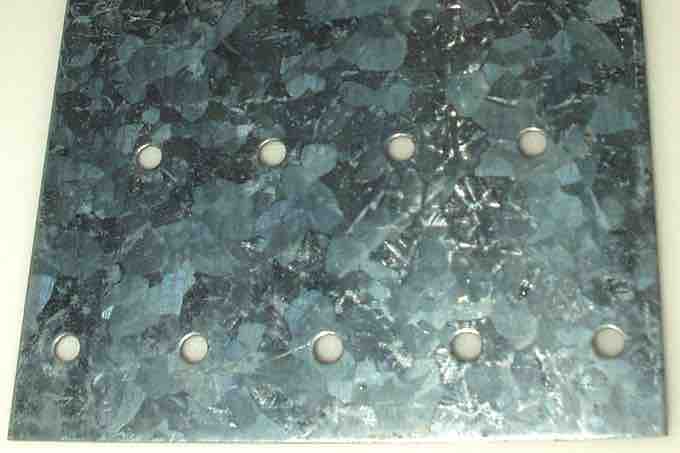Reviewing Corrosion
We have learned that three things are required for the anodic and cathodic steps of corrosion to occur: an electrolyte, an exposed metal surface, and an electron acceptor. It follows, then, that we can prevent corrosion by removing one of these essential conditions. The simplest condition to remove is the exposed metal surface.
Establishing a Physical Barrier
Coating a metal surface with paint or enamel provides a barrier between the metal and the moisture in the environment, thus removing the opportunity for both oxygen and moisture to come in contact with the metal.
Sacrificial Coatings
The process of coating a metal surface with another metal that is more likely to be oxidized is referred to as sacrificial coating. The corrosion-prone iron alloy steel is commonly coated with zinc, a more active metal, in a process known as galvanizing. Corrosion of the sacrificial zinc results in its oxidation; the iron is reduced, which renders it cathodic and inhibits its corrosion.

A galvanized surface
Protecting iron alloys with a coating of a more active metal through the process of galvanizing prevents the alloys from corroding.
A contrast to the previous scenario can be seen when iron or an iron alloy is plated with a less active metal, such as tin. As long as the tin coating remains intact, corrosion is not possible. If, however, the tin coating becomes degraded, exposing the underlying metal, corrosion will occur. This is because the exposed iron undergoes oxidation and is rendered anodic. The tin accepts electrons from the oxidized iron, and the three criteria for corrosion are met.
Cathodic Protection
Another way to protect against corrosion is to confer a continuous negative electrical charge on a metal. This method is referred to as cathodic protection. Cathodic protection replicates the effects of a sacrificial coating but with a more active metal. The source of negative charge is usually an external direct-current power supply. Cathodic protection is used to protect underground fuel tanks and pipelines, among other things.
Passivation
Passivation is a process through which a thin film of corrosion products builds on a metal surface to serve as a barrier against oxidation. The formation of a passivation layer is affected by environmental pH, temperature, and chemical conditions. The Statue of Liberty, for example, is coated with a blue-green patina caused by several chemical reactions, which serves to protect the copper metal underneath.
Anodization
Anodization is another surface treatment that protects against corrosion. The metal to be protected is bathed in a specific substance, and electrochemical conditions are adjusted such that uniform pores several nanometers wide appear in the metal's oxide film. These pores allow an oxide film, thicker than a passivation layer, to build up. The resultant protective layer is very hard and very resilient.
Sacrificial Anode Protection
Using the same principle as sacrificial film coating, a sacrificial anode, made of a metal more active than the metal you want to protect, can be used to prevent corrosion on submerged or buried metal structures. The sacrificial anode will corrode before the metal it is protecting does. However, once the sacrificial anode corrodes, it must be replaced; otherwise, the metal it is protecting will begin to corrode as well.
Cathodic protection prevents corrosion
Galvanic sacrificial anode attached to the hull of a ship; here, the sacrificial anode shows corrosion but the metal it is attached to does not. The anode, a piece of a more electrochemically "active" metal, is attached to the vulnerable metal surface where it is exposed to an electrolyte; the potential of the vulnerable surface is polarized to be more negative until the surface has a uniform potential. At that stage, the driving force for the corrosion reaction with the protected surface is removed. The galvanic anode continues to corrode, consuming the anode material until eventually it must be replaced, but the cathodic material is protected.
Corrosion presents a real threat to the integrity of personal property as well as to that of bridges, roads, and other public infrastructures. Understanding and implementation of strategies that prevent corrosion will decrease both the economic and safety-related damages associated with the process.